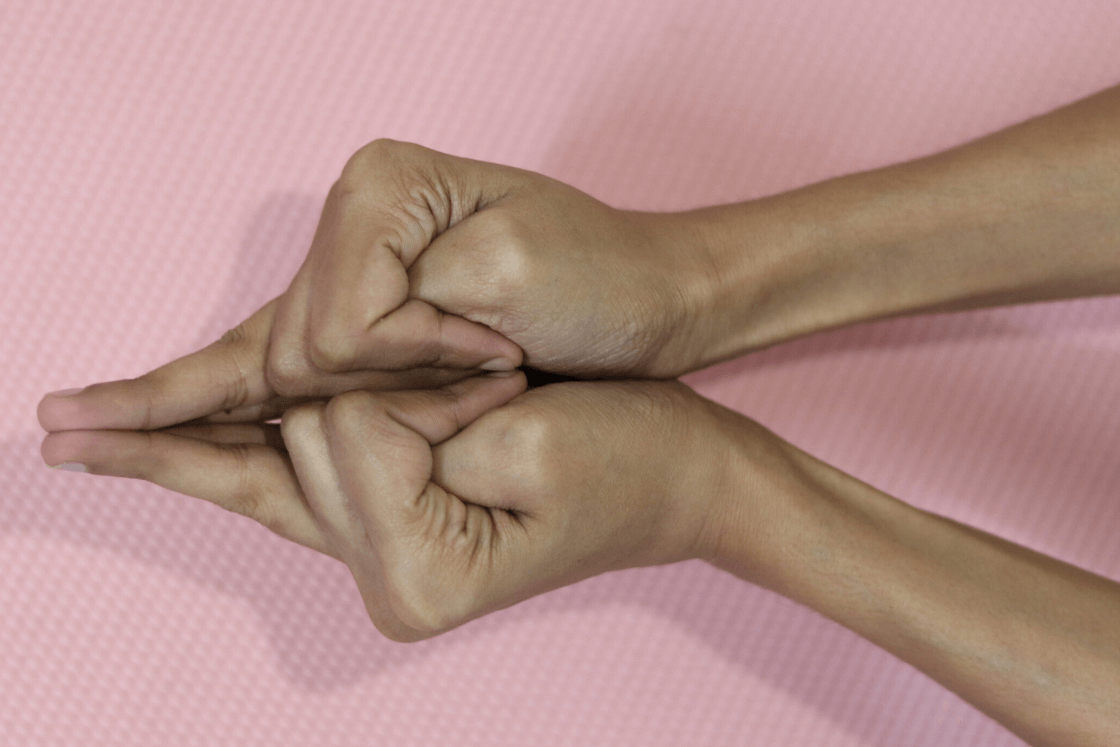
Shakti Mudra, often called the “Gesture of Power,” is a key hand gesture in yoga with deep roots in ancient practices. Known as Shakti Chalana Mudra, this gesture plays a significant role in balancing life-force energy, or prana, throughout the body. By incorporating this mudra into your routine, you tap into its ability to harmonize mental and physical states. Its practice is celebrated for enhancing inner strength and emotional stability.
This mudra is especially beneficial during meditation. It helps maintain focus and stillness, which can be challenging on days when distractions are strong. Shakti Mudra is also known for its calming effects, making it a valuable tool for managing stress and anxiety. By aligning with its energy, practitioners can achieve greater mental clarity and stability.
Meaning
The term “Shakti Mudra” is derived from Sanskrit, where “Shakti” means “power” or “strength,” and “Mudra” means “gesture” or “seal.” This hand gesture is deeply connected to the goddess Shakti, a representation of feminine energy, power, and creativity. Shakti, also known as the Hindu goddess Durga, embodies dynamic energy and inner strength.
The mudra is sometimes referred to as Shakti Chalana Mudra, with “Chalana” meaning “movement” or “flow” in Sanskrit. This name underscores the mudra’s purpose of directing and enhancing the flow of life-force energy (prana) throughout the body. By fostering this energy flow, Shakti Mudra supports balance and vitality, enhancing overall well-being and aligning with the body’s natural rhythms.
Connecting with svadhisthana chakra
When the Svadhisthana Chakra is balanced, we experience a heightened sense of self-worth and creative expression. We become more adaptable, empowered, and in tune with our inner wisdom. Shakti Mudra supports this by enhancing the flow of apana, the downward and outward energy in the abdomen and pelvis. This energy flow aids in digestion, elimination, and can alleviate menstrual discomfort.
How to do shakti mudra(steps)

- Sit in a comfortable pelvic-opening yoga posture like Malasana (Garland Pose) or Utkata Konasana (Goddess Pose). Alternatively, you can use traditional meditative poses such as Padmasana (Lotus Pose) or Sukhasana (Easy Pose).
- Close your eyes and take deep breaths to calm your mind and enhance the flow of prana (life-force energy).
- Tuck your thumbs into the center of your palms. Bend your index and middle fingers to lightly wrap around the thumb, creating a secure hold. Extend your ring and little fingers outward.
- Bring the ring and little fingers of both hands close together. Touch the distal phalanges (the tips) of your left hand’s ring finger to the distal phalanges of your right hand’s ring finger, and do the same with the little fingers.
- Connect the middle phalanges (the middle segments) of your index and middle fingers from both hands together.
- Bring your hands close to your chest while maintaining the finger arrangement. Focus on clearing your mind and deepening your breath. Chant “OM” if it helps with concentration.
Note: If sitting poses are uncomfortable, you can perform Shakti Mudra while standing in Tadasana (Mountain Pose) or sitting on a chair.
Time and duration
- Ideal Time: Shakti Mudra can be performed at any time that suits your schedule. However, it is especially effective if practiced just before bedtime to promote better sleep. Additionally, morning practice can help set a positive tone for the day.
- Duration: Each session should last between 10-12 minutes. For optimal benefits, aim to practice Shakti Mudra 2-3 times a day.
Precautions
- Apply gentle pressure with your fingers.
- Wear comfortable clothing and remove jewelry or accessories.
- Practice in a quiet, calm environment by turning off mobile phones, TVs, and radios.
- Practice in a quiet, calm environment by turning off mobile phones, TVs, and radios.
- Limit the duration to avoid lethargy; adhere to recommended time.
Side effects
While Shakti Mudra is generally safe, potential side effects may occur if not practiced properly. Over-practicing or holding the mudra for extended periods can lead to fatigue. It’s important to adhere to recommended practice times to avoid such issues.
Contraindications
- Consult a healthcare provider if pregnant or recently had surgery.
- Avoid if you have severe or chronic health conditions, particularly related to hands, wrists, or respiratory system.
Benefits of Shakti Mudra
- Prevents Sleep Disorders or Sleeplessness: Sleep disorders or sleeplessness are often caused by an unstable mind. Tension, stress, and pressure can disrupt the brain’s stability. Shakti Mudra helps address these issues by promoting relaxation and calming the nervous system, which can stabilize the mind and improve sleep quality.
- Improves the Immune System: Shakti Mudra enhances inner strength and stability in the body. The calming effect of this mudra boosts internal energy, contributing to a more robust immune system. This, in turn, helps keep the body fit and healthy. Additionally, Shakti Mudra can help alleviate general weakness, promoting overall well-being.
- The Perfect Remedy for Pelvic Area Disorders: Shakti Mudra directs prana to the pelvic area, soothing and calming both the region and its glands. It helps alleviate issues such as painful urination from prostate problems and menstrual discomfort caused by pelvic disturbances. Additionally, it can ease intestinal spasms linked to irritable bowel syndrome (IBS), enhancing overall pelvic health and comfort.
- Stimulates the Sacral Chakra: Regular practice of Shakti Mudra influences the sacral (Svadhisthana) chakra, located just below the navel and close to the pelvic area. By redirecting the flow of prana to this chakra, Shakti Mudra helps stimulate it, enhancing creativity, fearlessness, and self-worth.
- Balancing Kapha Dosha: Shakti Mudra’s stimulating and energising effects help counteract the qualities of Kapha, which include heaviness, coldness, and sluggishness. By enhancing the flow of prana (life-force energy) and promoting vitality, it helps reduce excess Kapha, alleviating symptoms such as lethargy, congestion, and fluid retention. The mudra’s ability to energise and balance the body aligns well with Kapha’s need for increased activity and warmth.
Conclusion
In conclusion, sleeplessness, tension, and stress are often the result of our daily habits and routines, indicating that it’s time to make adjustments to our lifestyle. Shakti Mudra provides a practical approach to tackling these issues, promoting relaxation and inner strength.
Regular practice of this mudra can help manage stress, improve overall well-being, and build a sense of inner power. Incorporating Shakti Mudra into your routine can lead to long-term health benefits and help you achieve a more balanced and harmonious life.
The post Shakti Mudra: How to Do, Benefits & Precautions appeared first on Fitsri Yoga.